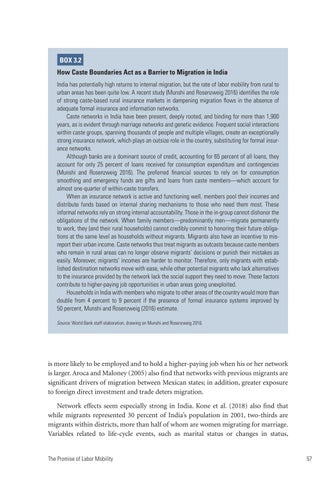BOX 3.2 How Caste Boundaries Act as a Barrier to Migration in India India has potentially high returns to internal migration, but the rate of labor mobility from rural to urban areas has been quite low. A recent study (Munshi and Rosenzweig 2016) identifies the role of strong caste-based rural insurance markets in dampening migration flows in the absence of adequate formal insurance and information networks. Caste networks in India have been present, deeply rooted, and binding for more than 1,900 years, as is evident through marriage networks and genetic evidence. Frequent social interactions within caste groups, spanning thousands of people and multiple villages, create an exceptionally strong insurance network, which plays an outsize role in the country, substituting for formal insurance networks. Although banks are a dominant source of credit, accounting for 65 percent of all loans, they account for only 25 percent of loans received for consumption expenditure and contingencies (Munshi and Rosenzweig 2016). The preferred financial sources to rely on for consumption smoothing and emergency funds are gifts and loans from caste members—which account for almost one-quarter of within-caste transfers. When an insurance network is active and functioning well, members pool their incomes and distribute funds based on internal sharing mechanisms to those who need them most. These informal networks rely on strong internal accountability. Those in the in-group cannot dishonor the obligations of the network. When family members—predominantly men—migrate permanently to work, they (and their rural households) cannot credibly commit to honoring their future obligations at the same level as households without migrants. Migrants also have an incentive to misreport their urban income. Caste networks thus treat migrants as outcasts because caste members who remain in rural areas can no longer observe migrants’ decisions or punish their mistakes as easily. Moreover, migrants’ incomes are harder to monitor. Therefore, only migrants with established destination networks move with ease, while other potential migrants who lack alternatives to the insurance provided by the network lack the social support they need to move. These factors contribute to higher-paying job opportunities in urban areas going unexploited. Households in India with members who migrate to other areas of the country would more than double from 4 percent to 9 percent if the presence of formal insurance systems improved by 50 percent, Munshi and Rosenzweig (2016) estimate. Source: World Bank staff elaboration, drawing on Munshi and Rosenzweig 2016.
is more likely to be employed and to hold a higher-paying job when his or her network is larger. Aroca and Maloney (2005) also find that networks with previous migrants are significant drivers of migration between Mexican states; in addition, greater exposure to foreign direct investment and trade deters migration. Network effects seem especially strong in India. Kone et al. (2018) also find that while migrants represented 30 percent of India’s population in 2001, two-thirds are migrants within districts, more than half of whom are women migrating for marriage. Variables related to life-cycle events, such as marital status or changes in status, The Promise of Labor Mobility
57

